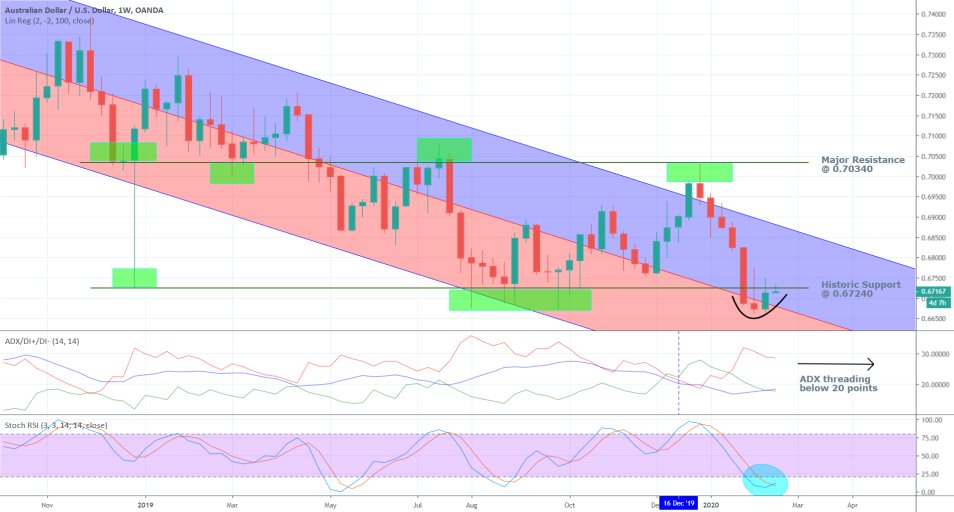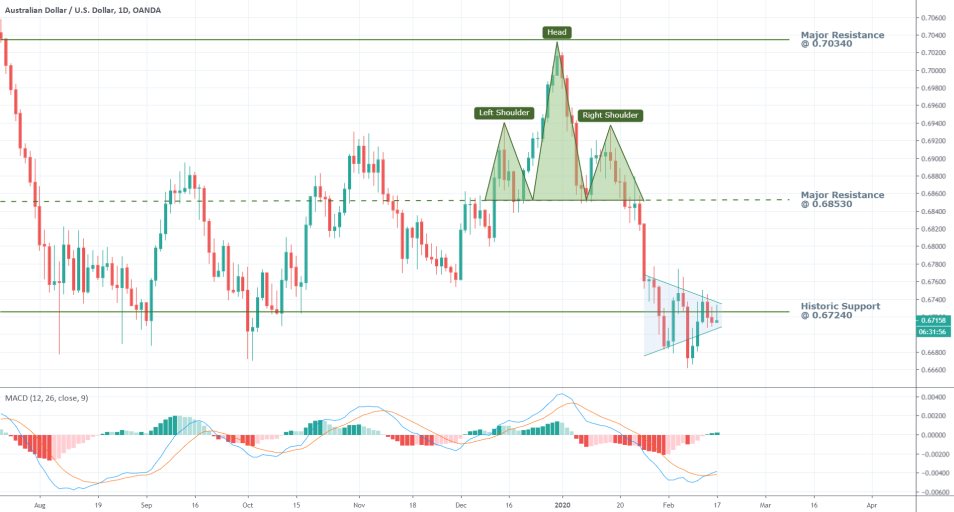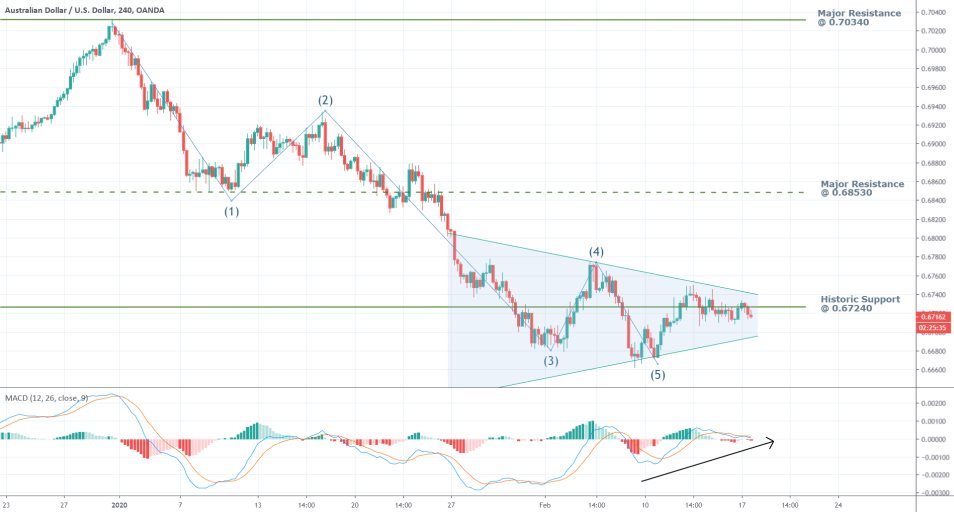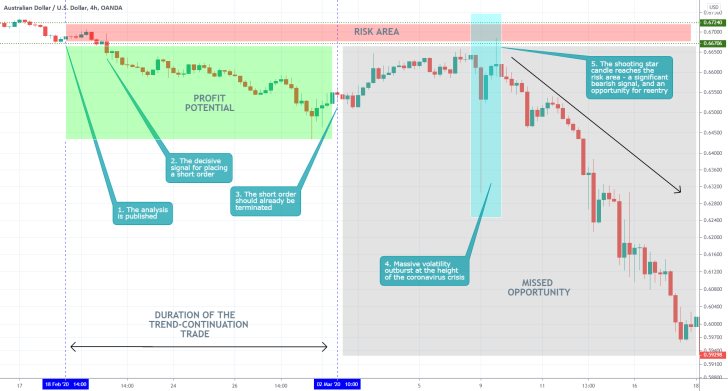The AUDUSD is currently trading around 0.66800, which is a level that was last reached in March of 2009. For the first time since the outbreak of the credit crunch in 2008, the Aussie finds itself so deeply undervalued, as geopolitical, environmental, biological and other reasons weigh down heavily on the currency. The seemingly endless string of internal and external pressures that underpin the bearish price action on the AUDUSD appears to be becoming increasingly more detrimental, and it shows no signs of slowing down, which is what's got investors and traders worried. Everybody wants to know whether a rebound in the price is possible to occur soon or the pair would continue to dig deeper into bearish territory.
This analysis aims to examine the current economic situations in Australia and the US, respectively, and subsequently to underscore the most likely development of the price action on the AUDUSD in the foreseeable future.
1. Long-Term Outlook:
The weekly price chart below reveals the current state of the major bearish trend. The price has managed to break down below the historic support level at 0.67240 and is currently consolidating just below it. What bulls want to know is whether the price would manage to get back above set support; however, the bears would like to know whether the current consolidation is a short-term break before the bearish trend continues to develop.
The first thing that has to be noted is the fact that the price has fallen to a decade’s low level, but the general market environment is not one that is trending. As the Average Directional Index (ADX) shows, the current price action can be qualified as threading in a very weak downtrend that is less than 20 ADX index points.
As can be seen, the price seems to be bouncing off the two boundaries of the linear regression channel each time it nears one of the two extremes, which is illustrative of the downwards-sloping range. This means that the linear regression channel’s three lines – the upper boundary; the lower boundary and the middle line – all act as important resistance and support levels. Why is this important?
The price is currently consolidating just below the historic support level at 0.67240 (presently acting as a resistance level) and above the linear regression channel's middle line, which is acting as a support level. This means that the price is more than likely to continue bouncing between the two in the short-term in this decidedly narrow price range before the price action can either resume its significant directional trading further south or correspondingly turn north. In other words, there are reasons to believe that for the time being the price would find it difficult to break down below the channel’s middle line. At the same time, the price hasn’t managed to close above the historic support (resistance) level at 0.67240 in the last two weeks, as indicated by the last two candlesticks’ long upper-shadows, which confirms the prevailing bearish sentiment in the market. Overall, the current market environment underpins the advantageous conditions that favour the implementation of range trading strategies.

The stochastic Relative Strength Index (RSI) demonstrates that the market has now entered into one of the two extremes – the AUDUSD is ‘Oversold’. In such a declining range environment (ADX<20) this might prompt the bulls to start entering long, which would likely prevent further depreciation of the pair for the time being.
2. Bushfires, the Coronavirus and Monetary Statements by the RBA and the FED:
Owing to the fact that the pair finds itself at the aforementioned historic low, its immediate behaviour is going to be determined by external fundamentals such as the current monetary policies of the two countries and other international precedents.
- In Australia. The Reserve Bank of Australia released its Monetary Policy Minutes from its last gathering two weeks ago, and the AUDUSD reacted by falling 0.50 per cent so far during today’s trading session.
The reason for the tumble is owing to the fact that the market does not believe that the expressed optimism by RBA’s Monetary Policy Committee (MPC) is going to persist in the current economic and geopolitical pressures worldwide.
“Members commenced their discussion of the global economy by noting the International Monetary Fund's forecast for global growth to pick up in 2020 and 2021. The easing in trade tensions between the United States and China, and ongoing stimulus delivered by central banks, had supported a modest improvement in the growth outlook for a number of economies. […] In major advanced economies, indicators for manufacturing and services activity had ticked up slightly and tight labour markets had supported growth in consumption.”
At the time of the report's publication, global manufacturing indeed seemed to be stabilising; however, now there are indications that those marginal signs of improvement are waning, and that the global industry is likely to continue suffering into Q1 of 2020.
Meanwhile, the projected improvement in economic growth was attributed mostly to the expectations for the stabilisation of global trade and the de-escalation of the tensions between the US and China. All of this relies on lessened uncertainty worldwide, however, the potential headwinds for the global economy, and on the Australian economy as well, are not yet completely removed.
“Members discussed the coronavirus outbreak, noting that it was a new source of uncertainty for the global economy. […] It was noted that previous outbreaks of new viruses had had significant but short-lived negative effects on economic growth in the economies at the centre of the outbreak. […] China now accounted for a much larger share of the global economy and was more closely integrated, including with Australia, than in 2003 at the time of the SARS outbreak.”
Overall, it can be asserted that the longer the crisis persists in China, the longer Australian growth could be jeopardised due to the close economic ties that are established between the two countries. Thus, investors' confidence in Australia is exceptionally responsive to adverse ripples in the Chinese economy, which means that the Australian dollar is likely to remain subdued for as long as the general uncertainty that currently weighs down on Chinese growth remains prevalent. In the past, this uncertainty was exerted by the trade war; however, the coronavirus seems to underscore it now.
One welcoming news is the temporary stabilisation of the weather conditions in Australia and the exhaustion of the damaging bushfires that raged towards the end of last year. Nevertheless, their impact on the economy is still likely to be felt, which is, therefore, going to harm the prospects for economic growth to a degree.
“The output of the farm sector had also subtracted from growth over the preceding year, reflecting the effects of ongoing drought conditions. Members noted that the recent bushfires had devastated some regional communities and that this was expected to have reduced GDP growth over the December and March quarters.”
Finally, the unemployment rate in Australia is expected to rise marginally in February by 0.1 percentage point to 5.2 per cent, which, if realised, is going to be reflected in ABS’s labour survey that is scheduled for release this Thursday.
Overall, the economic situation in Australia seems very dim at the current moment, and headwind pressures are likely to persist in the first fiscal quarter of 2020, which, in turn, is going to continue pressuring the Australian dollar. This does not necessarily mean that the AUDUSD is immediately going to resume trading in a sizable bearish trend; however, it means that the formation of a new bullish trend at the present moment seems almost impossible.
- In the US. The situation in the states is different. The resulting panic that is sweeping through the global stock markets is currently strengthening the greenback, as the demand for the world’s top currency always surges at times of great distress and general market fears.
The FED is also scheduled to release its Monetary Policy Minutes from its last meeting this Wednesday, which is more than likely to bolster the greenback in the short-term. Jerome Powell, the Chair of the FOMC, recently stated that low interest rates are now a fact of the economy, which is an indication that the FED's accommodative monetary policy is likely to remain prevalent well-into 2020.
Despite arguing that the American economy is currently doing quite well, Powell also underpinned the likely headwinds that could impede its growth in the mid-term, and these fears of his are likely to be fully developed in tomorrow’s Minutes report. Thus, the report itself could be less hawkish than some investors might think, which, in turn, is likely to curb the anticipated hike of the US dollar partially.
3. Short-Term Outlook:
As can be seen on the daily chart below, the price had recently broken down below the neckline of the head and shoulders pattern and has reached the aforementioned historic support.

The price is currently consolidating around set support in a small disjointed channel, which creates the so-called bottleneck effect – the price is likely to surge in either direction once it breaks out of the channel’s boundaries. Thus, the first major candle that breaks out of the disjointed channel’s structure is going to point to the next most likely direction for the price action. In the meantime, the price is likely to continue consolidating. The MACD underscores this temporary balance in the trading pressures, as the stochastic is threading close to the 0.00000 level and the momentum does not seem to have any prevailing dispositions.

The 4H chart above underpins the aforementioned disjointed channel in a more detailed fashion. The bottleneck effect – between the two trend lines of the disjointed channel – coincides precisely with the historic support level at 0.67240, which makes this price level even more crucial. In other words, the 0.67240 is becoming a very important turning point for the price action that is likely to represent the potential starting point for the next sizable price swing in either direction.
The 1-5 Elliott Wave pattern has been completed at (5), which raises the likelihood for the establishment of a momentary correction, which is inlined with the aforementioned arguments. The MACD, too, is consolidating around the 0.000 level, similar to the MACD on the daily chart, which confirms the current balance in the market. This balance is going to be terminated once the directional trading resumes.
4. Concluding Remarks:
Overall, the AUDUSD finds itself at the lower end of a major downswing, which means that a short-term consolidation is likely to take place before the directional trading is resumed. The price seems more likely to continue trading lower as opposed to establishing a new bullish trend, given the unfavourable fundamental conditions that are weighing down on the Aussie. Nevertheless, the price is already at a decade-long low, which means that some longer-term bears are going to start collecting their accumulated profits and thereby boost the overall demand by terminating their short orders.
It seems that the most likely development is one in which the price continues to consolidate around the historic support at 0.67240 as the overall volatility continues to lessen. The execution of more longer-term selling orders would be justified only if the price manages to break down below the linear regression channel’s middle boundary (the one on the weekly chart), which would manifest strong bearish commitment in the market.

- The short-term view of the analysis was mistaken because it underestimated the strain of the evolving coronavirus crisis on the value of the Australian dollar. However, the longer-term view was spot on in that the pair did indeed continue to slide. In fact, the depreciation of the AUDUSD exceeded the projections of the analysis, which is represented by the 'Missed Area' in grey. The biggest takeaway here is that sometimes traders need to have the mental agility to monitor the development of the market for months at a time, in order to catch such massive directional swings.
- As regards the short-term trade, the entry signal was almost flawless. The breakdown below the support level at 0.66700 did indeed signify the strengthening of the bearish sentiment in the market. An important takeaway from this trade is the need of traders to approach 'uncharted territory' with caution. In other words, when the price is entering into areas that have not been reached for years, they better use floating stop losses and take profits because they do not have many points of reference. Moreover, when the price action enters into such areas with historical significance, traders are more likely to anticipate a reversal, which seems logical. However, they cannot allow themselves to trade based on presumptions. Thus, traders should have the psychological constitution to be prepared for the unexpected and the illogical on the market.
Disclaimer: Your capital is at risk! Trading and investing on the financial markets carries a significant risk of loss. Each material, shown on this website, is provided for educational purposes only. A perfect, 100% accurate method of analysis does not exist. If you make a decision to trade or invest, based on the information from this website, you will be doing it at your own risk. Under no circumstances is Trendsharks responsible for any capital losses or damages you might suffer, while using the company’s products and services. For more information read our Terms & Conditions and Risk Disclaimer.





















